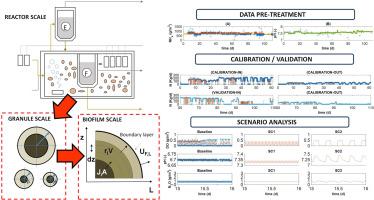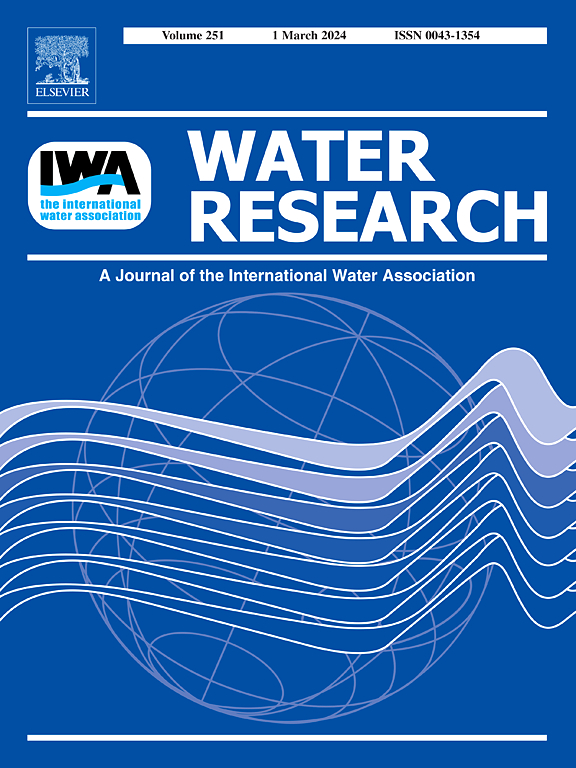Quantifying, predicting, and mitigating nitrous oxide emissions in a full-scale partial nitritation/anammox reactor treating reject water.
IF 11.4
1区 环境科学与生态学
Q1 ENGINEERING, ENVIRONMENTAL
引用次数: 0
Abstract
In this paper, a set of mathematical tools are developed and assembled to quantify, predict and virtually assess N2O emission migration strategies in partial nitritation (PN) / anammox (ANX) granular based reactors. The proposed approach is constructed upon a set of data pre-treatment methods, process simulation models, control tools (and algorithms) and key performance indicators to analyze, reproduce, and forecast the behavior of multiple operational variables within aerobic granular sludge systems. All these elements are tested on two full-scale data sets (#D1, #D2) collected over a period of four months (Sept-Dec 2023). Results show that data pretreatment is essential for noise reduction, filling data gaps, and ensuring smooth process simulations. The model accurately predicts (normalized RMSE< 1) multiple N oxidation states (NHx, NO2-, NO3-, N2O) and dissolved oxygen (DO), demonstrating its capability to describe bacterial behavior within the studied system. Special emphasis is placed on weak acid-base chemistry where pH is reliably reproduced, and it can be used for control purposes. Both biological and physico-chemical aspects are predicted at different time scales (months, days, minutes). While nitritation mainly occurred in the bulk, biofilm distribution showed inactive inner granule parts and increasing biomass (mostly ANX) towards the surface, with distinct organic concentrations. Gradients for multiple soluble compounds could also be reflected. The model revealed that the system was suffering from low ANX activity leading to NO2- accumulation. This in combination with low DO levels, resulted in nitrifier denitrification (ND) as the main identified N2O production pathway and an unusually high emission factor (EF) as a result. The validation data set also yielded satisfactory results (normalized RMSE< 1). The scenario analysis revealed that modification of the aeration patterns and operational volatile suspended solids (VSS) concentration could improve the ANX activity and lead to N2O emission rates that are in line with what is normally expected from similar systems. The study includes a discussion on transitioning from process models to digital shadows/ twins for real-time process monitoring. Additionally, it emphasizes the necessity of evaluating reject water technologies from a plant-wide perspective.

求助全文
约1分钟内获得全文
求助全文
来源期刊

Water Research
环境科学-工程:环境
CiteScore
20.80
自引率
9.40%
发文量
1307
审稿时长
38 days
期刊介绍:
Water Research, along with its open access companion journal Water Research X, serves as a platform for publishing original research papers covering various aspects of the science and technology related to the anthropogenic water cycle, water quality, and its management worldwide. The audience targeted by the journal comprises biologists, chemical engineers, chemists, civil engineers, environmental engineers, limnologists, and microbiologists. The scope of the journal include:
•Treatment processes for water and wastewaters (municipal, agricultural, industrial, and on-site treatment), including resource recovery and residuals management;
•Urban hydrology including sewer systems, stormwater management, and green infrastructure;
•Drinking water treatment and distribution;
•Potable and non-potable water reuse;
•Sanitation, public health, and risk assessment;
•Anaerobic digestion, solid and hazardous waste management, including source characterization and the effects and control of leachates and gaseous emissions;
•Contaminants (chemical, microbial, anthropogenic particles such as nanoparticles or microplastics) and related water quality sensing, monitoring, fate, and assessment;
•Anthropogenic impacts on inland, tidal, coastal and urban waters, focusing on surface and ground waters, and point and non-point sources of pollution;
•Environmental restoration, linked to surface water, groundwater and groundwater remediation;
•Analysis of the interfaces between sediments and water, and between water and atmosphere, focusing specifically on anthropogenic impacts;
•Mathematical modelling, systems analysis, machine learning, and beneficial use of big data related to the anthropogenic water cycle;
•Socio-economic, policy, and regulations studies.
 求助内容:
求助内容: 应助结果提醒方式:
应助结果提醒方式:


